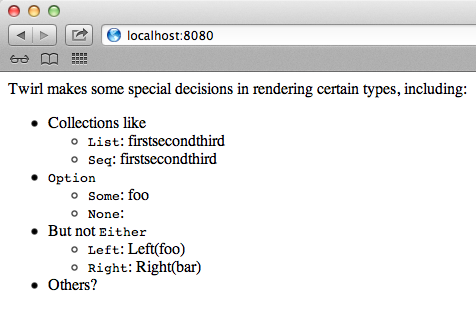Twirl
Twirl is the Play 2 templating language.
Evaluating Twirl
While the Scalatra developer generally prefer Scalate for server-side templating, Twirl provides an interesting alternative.
Advantages of Twirl
- Templates are rendered by simply calling a generated
renderfunction with the correct arguments. Since this call can be made from other templates, the artificial distinction between “layouts” and “views” is erased. - Twirl simply embeds Scala in arbitrary text, whether that text is HTML, JSON, XML, or anything else. There is no new language to learn.
- When you use Twirl, the compiler can check type errors within a template, but unlike Scalate it can also check that templates are being passed the right parameter types.
Disadvantages of Twirl
- Play 2 is legendary for its slow compile times, and the code Twirl produces is a major offender in that regard. If your project involves many templates, compile times will get progressively worse.
- Since Twirl is a general-purpose template languages, it is not nearly as DRY as Scalate’s Scaml or Jade languages for HTML/XML templates.
- There is no tooling support for Twirl. Get ready to hit the space and tab keys often.
- Twirl makes some undocumented rendering decisions with respect to certain types (see below).
Using Twirl
Installation
- Add the Twirl plugin to
project/plugins.sbt:
addSbtPlugin("com.typesafe.sbt" % "sbt-twirl" % "1.3.7")
- Enable the plugin in
build.sbt:
enablePlugins(SbtTwirl)
Usage
You add your templates to src/main/twirl.
Twirl files are of the form [name].scala.[format]. For example, foo.scala.html or
bar.scala.xml.
The package of the generated Scala file will follow the name of the template file,
and its path.
For example, if you create a file
src/main/twirl/com/example/myTwirlTemplate.scala.html, the resulting Scala file
will be in the package com.example.html.
You can call it with:
com.example.html.myTwirlTemplate.render(param1, param2, ...)
A basic example
Create src/main/twirl/org/scalatra/example/hello.scala.html with:
@(date: java.util.Date)
<html>
<body>
<h1>Twirl reporting for duty at @date.toString!</h1>
</body>
</html>
Now render it in src/main/scala/org/scalatra/example/ScalatraTwirlServlet.scala with:
package org.scalatra.example
import org.scalatra._
class ScalatraTwirlServlet extends ScalatraServlet {
get("/") {
org.scalatra.example.html.hello.render(new java.util.Date)
}
}
Your result?
Full usage guide
We have only provided a taste of what Twirl can do. Since it’s an external project, we encourage you to also consult the official documentation.
Rendering oddities
There are some undocumented conversions Twirl initiates before rendering. Beware!
Consider this template:
@()
Twirl makes some special decisions in rendering certain types, including:
<ul>
<li>
Collections like
<ul>
<li><code>List</code>: @List("first", "second", "third")</li>
<li><code>Seq</code>: @Seq("first", "second", "third")</li>
</ul>
</li>
<li>
<code>Option</code>
<ul>
<li><code>Some</code>: @Some("foo")</li>
<li><code>None</code>: @None</li>
</ul>
</li>
<li>
But not <code>Either</code>
<ul>
<li><code>Left</code>: @Left("foo")</li>
<li><code>Right</code>: @Right("bar")</li>
</ul>
</li>
<li>
Others?
</li>
</ul>
It will render as:

